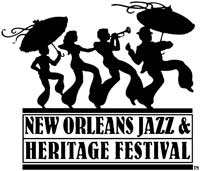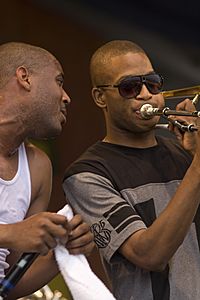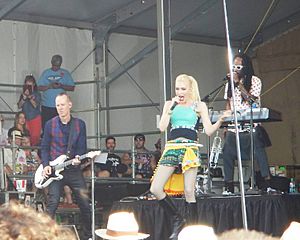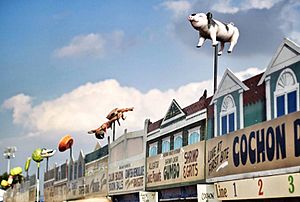- This page was last modified on 17 October 2025, at 10:18. Suggest an edit.
New Orleans Jazz & Heritage Festival facts for kids
"Jazz Fest" redirects here. For other jazz festivals, see List of jazz festivals.
| New Orleans Jazz & Heritage Festival | |
|---|---|
 |
|
| Genre | Jazz |
| Dates | April/May |
| Location(s) | New Orleans, Louisiana, U.S. |
| Years active | 1970–2019, 2021– |
| Founded by | George Wein |
The New Orleans Jazz & Heritage Festival, often called Jazz Fest, is a big yearly party in New Orleans, Louisiana. It celebrates the amazing music and culture of the city and state. When people say "Jazz Fest," they often mean not just the festival itself, but also all the extra concerts happening in local clubs during the festival weekends.
Contents
What is the New Orleans Jazz Fest?
Jazz Fest happens every year over two weekends. It starts on the last Thursday of April and runs until the first Sunday of May. The festival takes place from 11 a.m. to 7 p.m. at the Fair Grounds Race Course. This is a horse racing track right in the middle of New Orleans.
This festival is a huge attraction for tourists. It's almost as important for New Orleans' economy as Mardi Gras. Jazz Fest brings in about $300 million to the city each year! In the beginning, most performers were local artists. But as the festival became more popular, famous national acts started to join in too.
The festival's main goal is to celebrate the unique music and culture of New Orleans and Louisiana. This means you'll hear all kinds of music styles. These include blues, R&B, gospel, Cajun, zydeco, Afro-Caribbean, folk, Latin, rock, rap, country, and bluegrass. And, of course, there's lots of jazz, both old and new!
Delicious Food and Cool Crafts at Jazz Fest
Jazz Fest is also famous for its wide variety of local foods and handmade crafts. The festival has a rule: no regular "carnival food." Instead, you'll find over seventy food booths with special dishes. Some popular items include Mango Freeze, crawfish beignets, cochon de lait sandwiches, alligator sausage po' boy sandwiches, and boiled crawfish. You can also try softshell crab po'boys, Cajun jambalaya, jalapeño bread, and fried green tomatoes. Other tasty options are Oyster patties, muffulettas, red beans and rice, and crawfish Monica. There are also options for people who eat vegan or vegetarian food.
All the food sellers are carefully checked to make sure their food is good and safe to eat. Most foods are made with fresh, local ingredients and prepared by hand. All the food vendors are small businesses owned by people from New Orleans.
You'll find many craft booths all around the festival grounds.
- The Congo Square African Marketplace has unique items from local and international artists. It feels like a real marketplace, and many artists use old crafting methods.
- In the Contemporary Crafts area, you can find handmade clothes, leather items, jewelry, paintings, sculptures, and musical instruments. You can even watch artists showing how they work with metal, paint, pottery, and fabric.
- The Louisiana Marketplace offers baskets, hand-colored photos, jewelry, and art inspired by Louisiana's landscapes.
A special part of Jazz Fest is how it highlights Louisiana's unique cultures and history. Large areas are set aside to show different cultures found in the state. This includes the Cajun culture and the culture of people whose families came from the Canary Islands, called the Los Isleños.
- The Louisiana Folklife Village focuses on the state's art and culture.
- The Native American Village shares the traditions of Native American groups.
- The Grandstand also hosts cultural displays. Many of the artists demonstrating their skills have been recognized for their work by national art groups.
Throughout the festival, you can also see lively parades. These include parades by the Mardi Gras Indians, marching bands, brass bands, and social aid and pleasure clubs.
The History of Jazz Fest

Glen David Andrews with Troy "Trombone Shorty" Andrews
The first Jazz Fest was held in 1970. It was started by the New Orleans Hotel Motel Association. They created the "New Orleans Jazz & Heritage Foundation," which now owns the festival. The festival has happened every year since then, except for 2020. That year, it was canceled because of the COVID-19 pandemic.
A person named George Wein was hired to produce the festival. Wein had already produced other famous music festivals, like the Newport Jazz Festival. To help him in New Orleans, Wein got advice from local experts like Ellis Marsalis. Two important people who helped Wein were Allison Miner and Quint Davis. They knew a lot about jazz and found performers in local clubs, not just tourist spots. The very first person they booked was Snooks Eaglin, a street singer who played at the festival every year.
Allison Miner and Quint Davis helped run the festival for many years. Quint Davis is now the CEO of the company that produces the festival. Allison Miner is remembered for helping to create the New Orleans Jazz & Heritage Foundation Archive. This archive keeps recordings of musicians, photos, and other items related to the festival's history. After Allison Miner passed away in 1995, the stage where interviews were held was renamed the Allison Miner Music Heritage Stage in her honor.
Before the current Jazz Fest, other jazz festivals happened in New Orleans in the 1960s. The first two Jazz Fests in 1970 and 1971 were held at Louis Armstrong Park, in a place called Congo Square. In 1972, the festival moved to the much larger New Orleans Fair Grounds and Racetrack. This venue is about ten minutes from the French Quarter. Organizers realized how popular the festival was becoming, so they needed a bigger space.
The very first Jazz Fest in Congo Square cost only $3 to get in. It didn't have much advertising. It had just one Gospel Tent and four open stages, many without microphones. Musicians even stayed in the homes of Davis and Miner because there wasn't money for hotels.
The first festival featured amazing artists like Mahalia Jackson, the Preservation Hall Jazz Band, Duke Ellington, Pete Fountain, Al Hirt, Clifton Chenier, Fats Domino, and The Meters. Only about 350 people attended that first year. But the numbers grew every year, especially after 1975. That's when they started making special limited-edition posters for the festival. By the late 1980s, attendance reached 300,000 people! In 2001, when they celebrated Louis Armstrong's 100th birthday, 650,000 people came to Jazz Fest.
The festival posters are very popular with collectors. Each year, a new poster is created by a different artist. These posters often feature a performer or the festival's theme. In 1998, they also started a separate Congo Square poster series.
2020 Festival Cancellation
On April 16, 2020, it was announced that the 2020 Jazz Fest would be canceled. This was due to the worldwide COVID-19 pandemic. The 51st festival was then planned for 2021 instead.
The Jazz & Heritage Foundation
The New Orleans Jazz & Heritage Foundation owns the Jazz & Heritage Festival. This foundation is a non-profit group. It uses the money from the festival to help the community through programs in education, business, and culture. The Foundation also owns the radio station WWOZ.
Since 2006, the main sponsor of the festival has been the Royal Dutch Shell company. That's why the festival's full name is "The New Orleans Jazz & Heritage Festival presented by Shell." Many of the stages are named after sponsors, like the Acura Stage or the Gospel Tent.
The Foundation has many programs.
- Their educational programs include The Don Jamison Heritage School of Music.
- They help with economic development through grants to local groups and programs that help musicians buy homes.
- For cultural purposes, the foundation organizes other festivals throughout the year. These include the Crescent City Blues and BBQ Festival, Fiesta Latina, and the Treme Creole Gumbo Festival.
Since 1979, the Foundation has given over $1 million in grants. These grants help local schools, artists, and musicians.
Who Performs at Jazz Fest?
Every year, Jazz Fest features a wide range of musicians. You'll see famous Louisiana artists and even international pop stars. Many popular New Orleans musicians have played at the festival every year for a long time. These include the Neville Brothers, Dr. John, Ellis Marsalis, and The Radiators.
If a band wants to perform at Jazz Fest, they usually need to be from Louisiana. This helps the festival promote and keep local culture alive.
Stages and Tents at the Festival

No Doubt perform at the New Orleans Jazz & Heritage Festival on May 1, 2015
Jazz Fest has 12 music stages and tents of different sizes. There are also two stages just for food demonstrations. Here's a look at some of the main stages:
| Stages/tents | What You'll Find There | |
|---|---|---|
| 1 | Acura Stage | This is the main stage where big-name performers play. |
| 2 | Gentilly Stage | This is the second main stage, also featuring popular acts. |
| 3 | Congo Square Stage | Here you'll hear music from Africa and other parts of the world. |
| 4 | Jazz Tent | This tent features modern jazz music. |
| 5 | Blues Tent | You can enjoy blues music in this tent. |
| 6 | Gospel Tent | This tent hosts gospel music groups and singers. |
| 7 | Fais Do-Do Stage | Listen to Cajun and zydeco music here. |
| 8 | Economy Hall Tent | This tent is for traditional New Orleans jazz. |
| 9 | Jazz & Heritage Stage | You'll see New Orleans brass bands and Mardi Gras Indians perform here. |
| 10 | Lagniappe Stage | This stage offers a mix of different sounds and styles. |
| 11 | Allison Miner Music Heritage | This is where you can find interesting talks, interviews, and discussions about music. |
| 12 | Kids Tent | This tent has music and performances just for children. |
| 13 | Food Heritage Stage | Local chefs show how to make delicious New Orleans dishes. |
| 14 | Cajun Cabin | Watch demonstrations of Cajun cooking here. |









